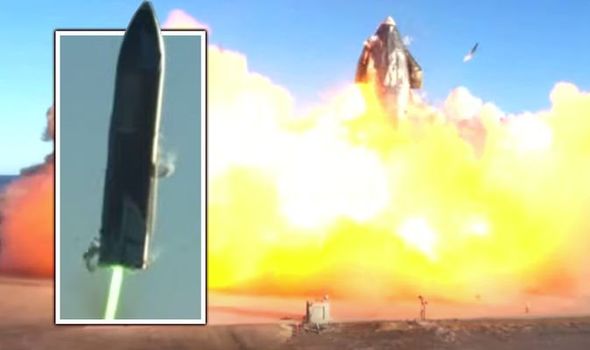Once the rocket was in the air, it began flying effoprtlessly above the clouds.
The rocket then completed a full circle before landing back on the ground.
However, the rocket exploded on impact with the ground – although SpaceX anticipated faults in this launch.
Elon Musk’s firm said: “As early as Wednesday, December 9, the SpaceX team will attempt a high-altitude suborbital flight test of Starship serial number 8 (SN8) from our site in Cameron County, Texas.
Everyday Astronaut asked Mr Musk on Twitter: “Was that engine shutdown on ascent intentional? Did it reached planned apogee? Can’t believe how epic that was Exploding head
“The schedule is dynamic and likely to change, as is the case with all development testing.
“This suborbital flight is designed to test a number of objectives, from how the vehicle’s three Raptor engines perform to the overall aerodynamic entry capabilities of the vehicle (including its body flaps) to how the vehicle manages propellant transition.
“SN8 will also attempt to perform a landing flip maneuver, which would be a first for a vehicle of this size.
“With a test such as this, success is not measured by completion of specific objectives but rather how much we can learn, which will inform and improve the probability of success in the future as SpaceX rapidly advances development of Starship.”
However, SpaceX added that there is “uncertainty” over the launch.
The Starship is a staggering 164ft (50m) tall, 200-ton, or 1,400 tons when fully loaded.
The Starship prototype is constructed of eye-catching stainless steel instead than the carbon composite or aluminium-based materials.
This gives the SpaceX Starship “exceptional thermal properties” and a lower cost.
A refined Starship paired with a SpaceX Super Heavy booster stage will increase the rocket’s height to 387ft (117m) and capable of carrying 220,000 pounds.
Starship will take humans across the solar system, and be able to return them to Earth.
It will first be used to ferry humans to the Moon, and eventually Mars when the time comes.
SpaceX president and chief operating officer Gwynne Shotwell said during a recent NASA-organised CLPS teleconference that Starship could be used to get humans to the Moon – which will be used as a jumping and refuelling point in the voyage to the Red Planet – in as little as three years.
Ms Shotwell said: “We are aiming to be able to drop Starship on the lunar surface in 2022.”
SOURCE






